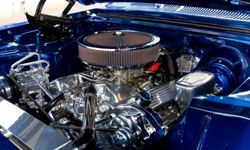When we're talking about engines, we often say something is a "four cylinder" or a "six cylinder." But what does that really mean exactly? For those not familiar with engine basics, a "cylinder" is the space in which a piston travels, and pistons are vital parts inside most engines driven by internal combustion.
Basically, gasoline and air mix together in the combustion chamber above a piston. When an electrical spark ignites that mix, it creates a tiny explosion that drives the piston up and down. That movement turns a crankshaft, which is ultimately responsible for driving a transmission and the wheels.
Advertisement
As you might expect, pistons are subjected to more heat, pressure and movement than nearly any other engine part. They have to be built for durability. With engines constantly evolving, carmakers keep finding new ways to built better pistons, including altering their size and composition.
The piston is at the heart of how an engine creates motion. Adding pistons to an engine or making them bigger increases displacement, which means the engine generates more power because it burns more gasoline.
The number of pistons in an engine isn't the only important thing about them, however. The shape of a piston has a big effect on the internal combustion process. Mainly, the shape of a piston has a lot to do with how heat and the air/fuel mixture are managed.
Let's first talk about different piston shapes. Pistons that are elliptical, or shaped like ovals, become more circular when heat is applied. This allows for improved sealing when the cylinder meets the combustion chamber for greater efficiency. Some pistons are tapered or conical, which lets the piston move more freely regardless of how much heat is present. Others are "barrel" shaped, which is smoother and generates less noise and harshness as it moves [source: University of Windsor].
Next, let's learn more about how the top of a piston affects performance, fuel economy and engine longevity.
Advertisement



